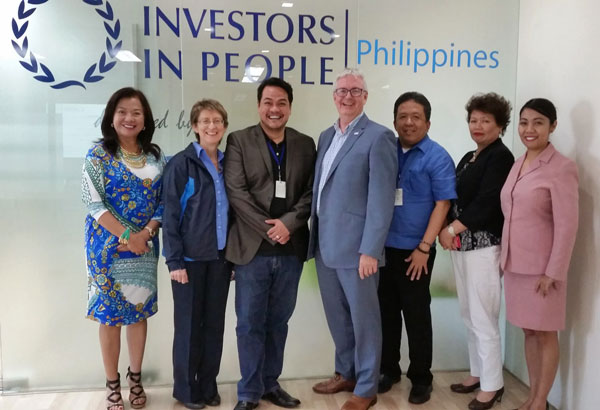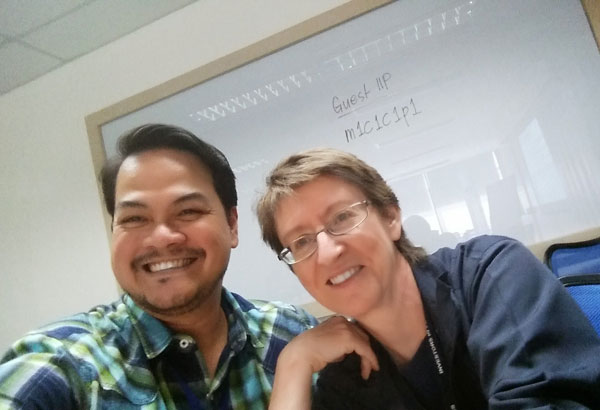How management chooses to treat its people impacts everything — for better or for worse. – Simon Sinek
Allow me to share a development in my career:
Investors in People (IIP), a UK-based organization that provides advice and assessment services to help companies focus their people management on their business priorities, recently awarded accreditation to me as an Investors in People Specialist.
It is an honor to be considered a specialist of an internationally recognized framework that helps organizations improve their performance and realize their objectives through the effective management and development of their people. It is a doubly amazing for me to be one of the select few in the Philippines. There are only eight as of the moment. To be part of this elite group of seasoned people management and organizational development professionals is quite humbling.
Most people congratulate me for getting a new job, but actually, it’s not. Being with IIP actually complements my existing work and business.

Lifestyle Feature ( Article MRec ), pagematch: 1, sectionmatch:
The author with David Dale, Operations Director of Investors in People International and other IIP specialists. David said in his confirmation letter, “I am very happy to confirm Boris’s registration as an Investors in People Specialist Advisor and Assessor, and I believe he will be a valuable asset to IIP in the Philippines and in the wider Investors in People international community for many years to come.”
As an IIP Adviser, I get to support and guide organizations who are pursuing the IIP standard and prepare their work against these criteria from detailed evidence requirements.
As an IIP Assesor, I get to lead or conduct an external assessment to ensure the organization has met these principles and underpinning criteria. Supporting evidence for the assessment is gathered from a range of sources and is not necessarily paper based. Evidence includes verbal and observed feedback, for example, through one-to-one interviews with employees or staff appraisal. As long as the criteria are adhered to, there is complete flexibility in how the organization seeks to improve its staff development.
As Tess Villanueva, seasoned HR/OD practitioner and fellow IIP specialist, said, “…being part of Investors in People is the crowning glory for any professional doing work in human resources, organizational development and training.” That is so true. At the top of your practice, it is a professional privilege to be able to assess — much more give advice — to other organizations in various industries.
Aligning Business Priorities with People Strategy
Throughout my career, especially in sales-driven or marketing-driven companies, I have always advocated for the alignment of business priorities and people strategy, simply because acquisition and customer satisfaction or retention are affected primarily by sales executives and customer service staff – by people. And they need to be highly motivated to be effective! I have always pushed for the HR agenda to be on the executive table. In the same manner, what do not sit well with me are HR groups that operate in silos as if their recruitment and practices do not directly affect our productivity levels. I have always believed that while the HR strategy belongs to the HR department, people strategy belongs to every manager.
And that’s what I love about the Investors in People framework and principles. IIP provides a standard as a business improvement tool designed to advance an organization’s performance through the management and development of their people. It’s an integration model that brings forth synergy and uses metrics to measure results in relation to overall performance. Working with the IIP framework derives a number of benefits for both the organization and its personnel:
Benefits to the Organization
· The Investors in People offers a recognized benchmark of an organization’s employee management to other entities as well as making an internal commitment to its staff to continually improve its standards over a long period of time.
· The Standard offers organizations a method for improving its staff management, employee satisfaction, motivation and access to training and development.
· Applying the Standard encourages a culture of continuous improvement and an opportunity to review current policies against a holistic framework.
· Aside from improved performance, the other competitive advantage is that IIP is widely recognized and the Standard acts as an independent stamp of approval for both prospective staff and potential customers.
· The focus on linking employees’ development and skills with an organization’s overall strategies has the potential to result in gains in overall organizational performance.
Benefits for the People
· The standard and approach are inclusive, involving all people who work for an organization in any capacity (for example, paid full-time, part-time staff, consultants and volunteers), particularly relevant to the diverse employment structures of many voluntary and socially enterprising organizations.
· It helps the organization foster a positive working environment that recognizes and appreciates people for their contribution.
· IIP recommends appropriate intervention such as coaching, adaptive learning and quality training when required.
· As a result of such positive working environment, job satisfaction and motivation are improved.
· There is better communication across all levels in the organization.
· Trust and transparency are built between top managers and their people.
In general, when an organization subjects itself to IIP assessment and advice, this results in increased motivation seen in employees’ greater involvement, personal development and recognition of their achievements. This leads to higher morale, improved retention rates, reduced absenteeism, higher acceptance of change, and identification with the organization’s goals beyond the confines of the job.
Once the organization has been recognized as an ‘Investor in People’, it is subject to regular reviews no more than three years apart. An organization can be assessed on a more regular basis if it so wishes.
IIP also offers a free online business support tool called IIP Interactive. It is designed to guide the user through development activities and help transform the performance of their organization. Built into the tool is a diagnostic that provides a snapshot of the organization’s current performance in relation to achieving the Investors in People Standard.

The author with Janet Webster-Watson, Chair of the Investors in People centre in the Philippines. “Clients have described Boris as being ‘insightful’ and I can see that. I can see how he can also be seen as inspirational in his approach to leadership and management. His easy going and friendly manner will also serve him well in engaging with people at all levels.”
Personally, an Iron-Sharpening Involvement
More than just the accreditation and additional work assignments, being part of this community of ‘investors in people’ allows me to develop critical skills for my work as a consultant and developer and deliverer of training programs.
IIP has trained me to suspend judgment and to apply the four-stage assessment methodology, ORCE, in all business cases. ORCE stands for Observe, Record, Classify (although I prefer to call it Categorize) and Evaluate. Used throughout the UK and USA, this methodology generates high-quality documented evidence regarding any candidate for accreditation, whether individual or organization.Unlike traditional methods of assessment that often combine observation and evaluation, ORCE includes two additional stages in the assessment process. These two stages are to ‘Record’ and ‘Classify’ the evidence gathered during observation in order to permit a fairer, more objective final evaluation.
As I suspend my assumptions, I am also trained to improve the quality of my conversations. There are four elements in our client conversations that I need to constantly improve in, which you might find useful in managing your team or clients:
1. Listening: To go beyond passive and active listening. In listening, it can be tempting to appear to be paying attention but only to arm oneself with what to say next. There’s internal chatter that distracts the person from truly listening to the other. In contrast, listening with empathy is whole system listening: it’s listening to what is happening to the client as he speaks — physically, mentally and emotionally. The internal chatter is off and there is full awareness to what the other person is saying consciously and subconsciously. It builds mutual respect and helps you manage and maintain safety for the other person.
2. Inquiry: To craft powerful and strategic focused questions. The construction of a question can make a significant difference to the answer and insight gleaned. The less powerful questions are those answerable by yes or no; which answer who, which, where, and when questions. The more powerful questions are the ones that answer the questions what, how, why and what if.
“A world of questions is a world of possibility. Questions open our minds, connect us to each other, and shake outmoded paradigms.” Marilee Adams (Change your Questions, Change your Life)
3. Advocacy: Here, I am trained to (1) challenge ideas constructively, which means identifying biases and pre-determined mindsets, and eventually (2) provide conscious intervention from the dialog or conversation to allow clients to see the issue from a new perspective or to facilitate deeper understanding.
Investors in People encourages all organizations that go through the IIP standard or accreditation to intentionally pursue sustainable improvement.
I just love the advocacy for continuous learning and improvement. For the company, it’s innovating and being flexible to ensure that everybody in the organization learns and grow. It’s institutionalizing succession planning and generational growth.
For me as an IIP Specialist, it means that the learning never stops. I just passed a grueling knowledge test that made me master success indicators and several evidence requirements and now I was told that we’re learning a new framework to be implemented next year. The new set of indicators and themes are based on a 2014 global research on valuing your talent research conducted by the Chartered Institute of Personnel and Development (CIPD) and the Chartered Management Institute (CMI), among others.
Talent management is constantly evolving, so we as specialists and practitioners must be up-to-date with the latest trends other than being knowledgeable about best practices and models on strategy, metrics, leadership, management, learning & development, maximizing human capital and even social responsibility.
Those people who develop the ability to continuously acquire new and better forms of knowledge that they can apply to their work and to their lives will be the movers and shakers in our society for the indefinite future. – Brian Tracy
* * *
Boris Joaquin is a top-ranked public speaker and masterful trainer for leadership programs and other soft skills. He is a seasoned management consultant, being involved in various industries and business sizes, from multinationals to locally owned enterprises. Presently, he’s the President & Chief Equipping Officer of Breakthrough Leadership® Management Consultancy, Inc.
Boris is now a registered Investor in People Specialist. You may be able to contact Boris at (02) 813-2703/32 or email trainings@breakthroughleadership.asia
![]()